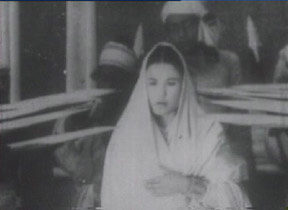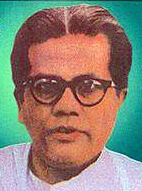A Journey That Started with a Dream
Aideu Handique, also known as Aideu Nilambar Handique, holds a unique place in the history of Assamese cinema as its first actress. Born in 1915 in a poor family in Panidihingia, Golaghat, Assam, she became a part of the first Assamese film, Joymati (1935). The film was directed and produced by the legendary Jyotiprasad Agarwala and was based on the story written by Lakshminath Bezbaruah. While her role in the film made history, her life afterward became a tale of struggle and sacrifice.
The Selection for Joymati
Aideu was just 16 when her cousin showed her picture to Jyotiprasad Agarwala. Impressed by her innocent look, he decided to cast her as Joymoti. However, acting was considered taboo for women at that time, and Aideu was initially reluctant to accept the role. But under the careful guidance of Jyotiprasad, she learned the art of acting—how to express emotions, how to walk, and how to speak in front of the camera. Despite her fears, she delivered a remarkable performance that left a lasting impression in the history of Assamese Cinema.
From Stardom to Social Exclusion
While her performance in Joymati was appreciated, life took a cruel turn when she returned to her village. Instead of being welcomed as a pioneer, she and her family were ostracized by society. Acting was considered inappropriate for women, and villagers believed that she had dishonored traditions by staying with men during the film’s shooting. Her parents, fearing social rejection, refused to let her enter the house. As a result, Aideu lived in a small cowshed, a thatched hut, for over seven decades in extreme poverty.
The Social Stigma That Ruined Her Personal Life
During the film, Aideu had to address her on-screen husband as Bongohor-deo (meaning husband). This simple act led to severe consequences—no one in the village was willing to marry her. Society believed that since she had already addressed someone as her husband in the film, she was no longer suitable for marriage. This deep-rooted belief left Aideu to live a life of solitude, never experiencing the companionship of marriage.
A Life of Neglect and Struggle
After Joymati, Aideu did not receive any further film offers. Worse, she never even got to watch her own performance on the big screen. The film that she had sacrificed everything for became a distant memory. It wasn’t until 1985, during the golden jubilee celebration of Assamese cinema, that the state government acknowledged her contribution. As a token of respect, she was given a cassette of the remaining footage of Joymati and awarded a pension of Rs 1,000 per month.
The Late Recognition
Even though Aideu Handique lived in poverty and social neglect for most of her life, she remained a strong woman. It was only in her later years that her contribution to Assamese cinema was recognized. Filmmakers, journalists, and cinema enthusiasts started to document her life, bringing her story to light. However, this recognition came too late to change her fate.
Her Final Days
After years of battling illness, Aideu Handique passed away on December 17, 2002. Though she left the world in pain and solitude, her legacy as the first Assamese actress remains immortal. She paved the way for future generations of female artists, breaking barriers in an era when women were not even allowed to step into the world of cinema.
The Forgotten Star Who Shaped Assamese Cinema
Aideu Handique’s story is one of passion, sacrifice, and an unwavering commitment to art. While society failed to appreciate her during her lifetime, history will always remember her as the woman who dared to step into the unknown and create a path for others to follow. Her struggles remind us of the deep-rooted societal norms that once held women back, and her courage continues to inspire future generations.
Even though she lived in obscurity, the name Aideu Handique will forever be written in golden letters in the history of Assamese cinema.
FAQ’s:
Q 1. Who was Aideu Handique?
Aideu Handique was the first actress in Assamese cinema. She played the lead role in the film Joymoti (1935), which was directed and produced by Jyotiprasad Agarwala. Despite her contribution to Assamese cinema, she faced social rejection for acting in a film, which was considered taboo for women at that time.
Q 2. Why was Aideu Handique rejected by society?
After acting in Joymoti, Aideu Handique was ostracized by her village because people believed that a woman who had worked with men in a film was not suitable for marriage. She had also called her co-actor “Bongohordeo” (husband) in the film, which added to the social stigma.
Q 3. What struggles did Aideu Handique face after Joymoti?
After her role in Joymoti, she was not accepted back into her community. Her own family distanced themselves due to societal pressure, and she was forced to live in isolation for the rest of her life. She remained unmarried and spent most of her life in poverty.
Q 4. Did Aideu Handique act in any other films?
No, Joymoti was her only film. She did not receive any other acting offers, and due to the backlash she faced, she never returned to the film industry.
Q 5. Did Aideu Handique ever get recognition for her work?
For many years, she was forgotten. However, during the golden jubilee celebration of Assamese cinema in 1985, the government acknowledged her contribution and presented her with a cassette of the remaining footage of Joymoti. She was also given a pension of ₹1,000 per month.
Q 6. How did Joymoti impact Assamese cinema?
Joymoti was the first Assamese film and played a crucial role in shaping the film industry in Assam. It set the foundation for future filmmakers and highlighted historical stories from Assam’s past. Despite its historical importance, the film did not bring fame or fortune to Aideu Handique.
Q 7. What was Aideu Handique’s life like after acting?
She spent the rest of her life in a small thatched hut near her family home in Panidihingia, Golaghat. She lived in extreme poverty and never married. Her sacrifices and struggles were only recognized decades later.
Q 8. Why did Aideu Handique never get married?
Apart from social rejection, one reason was that she had called her on-screen husband by that title in the film. During that time, it was believed that calling someone “husband” in public meant an actual marriage. Because of this, no one wanted to marry her.
Q 9. When did Aideu Handique pass away?
After suffering from a long illness, she passed away on December 17, 2002. She was 87 years old at the time of her death.
Q 10. What is Aideu Handique’s legacy today?
Aideu Handique is now remembered as a pioneer in Assamese cinema. Her story is one of sacrifice and resilience, highlighting the struggles of women in the early days of Indian cinema. Today, she is honored for her bravery and contribution to Assamese culture.












